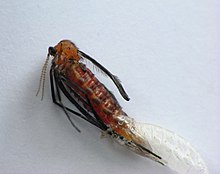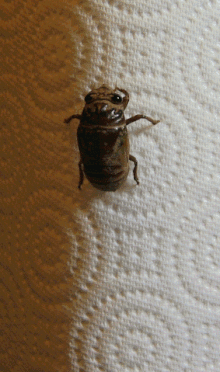This articleneeds additional citations forverification.(May 2024) |
Ecdysisis themoultingof thecuticlein many invertebrates of the cladeEcdysozoa.Since the cuticle of these animals typically forms a largely inelasticexoskeleton,it is shed during growth and a new, larger covering is formed.[1]The remnants of the old, empty exoskeleton are calledexuviae.[2]


After moulting, an arthropod is described asteneral,acallow;it is "fresh", pale and soft-bodied. Within one or two hours, the cuticle hardens and darkens following atanningprocess analogous to the production ofleather.[3]During this short phase the animal expands, since growth is otherwise constrained by the rigidity of the exoskeleton. Growth of the limbs and other parts normally covered by the hard exoskeleton is achieved by transfer of body fluids from soft parts before the new skin hardens. A spider with a small abdomen may be undernourished but more probably has recently undergone ecdysis. Some arthropods, especially large insects with tracheal respiration, expand their new exoskeleton by swallowing or otherwise taking in air. The maturation of the structure andcolourationof the new exoskeleton might take days or weeks in a long-lived insect; this can make it difficult to identify an individual if it has recently undergone ecdysis.
Ecdysis allows damaged tissue and missing limbs to beregeneratedor substantially re-formed. Complete regeneration may require a series of moults, the stump becoming a little larger with each moult until the limb is a normal, or near normal, size.[4]
Etymology
editThe termecdysiscomes fromAncient Greekἐκδύω(ekduo) 'to take off, strip off'.[5]
Process
editThis section includes a list ofgeneral references,butit lacks sufficient correspondinginline citations.(May 2024) |
In preparation for ecdysis, the arthropod becomes inactive for a period of time, undergoingapolysisor separation of the old exoskeleton from the underlying epidermal cells. For most organisms, the resting period is a stage of preparation during which the secretion of fluid from the moulting glands of the epidermal layer and the loosening of the underpart of the cuticle occurs. Once the old cuticle has separated from the epidermis, a digesting fluid is secreted into the space between them. However, this fluid remains inactive until the upper part of the new cuticle has been formed. Then, by crawling movements, the organism pushes forward in the oldintegumentary shell,which splits down the back allowing the animal to emerge. Often, this initial crack is caused by a combination of movement and increase in pressure of hemolymph within the body, forcing an expansion across itsexoskeleton,leading to an eventual crack that allows for certain organisms such asspidersto extricate themselves. While the old cuticle is being digested, the new layer is secreted. All cuticular structures are shed at ecdysis, including the inner parts of the exoskeleton, which includes terminal linings of thealimentary tractand of thetracheaeif they are present.
Insects
editEach stage of development between moults for insects in the taxonEndopterygotais called aninstar,or stadium, and each stage between moults of insects in theExopterygotais called a nymph: there may be up to 15 nymphal stages.Endopterygotatend to have only four or five instars. Endopterygotes have more alternatives to moulting, such as expansion of the cuticle and collapse of air sacs to allow growth of internal organs.
The process of moulting in insects begins with the separation of the cuticle from the underlying epidermal cells (apolysis) and ends with the shedding of the old cuticle (ecdysis). In many species it is initiated by an increase in thehormoneecdysone.This hormone causes:
- apolysis – the separation of the cuticle from theepidermis
- secretionof new cuticle materials beneath the old
- degradation of the old cuticle
After apolysis the insect is known as apharate.Moulting fluid is then secreted into the exuvial space between the old cuticle and the epidermis, this contains inactive enzymes which are activated only after the newepicuticleis secreted. This prevents the newprocuticlefrom getting digested as it is laid down. The lower regions of the old cuticle, theendocuticleandmesocuticle,are then digested by the enzymes and subsequently absorbed. Theexocuticleand epicuticle resist digestion and are hence shed at ecdysis.
Spiders
editSpiders generally change their skin for the first time while still inside the egg sac, and the spiderling that emerges broadly resembles the adult. The number of moults varies, both between species and sexes, but generally will be between five times and nine times before the spider reaches maturity. Not surprisingly, since males are generally smaller than females, the males of many species mature faster and do not undergo ecdysis as many times as the females before maturing. Members of theMygalomorphaeare very long-lived, sometimes 20 years or more; they moult annually even after they mature.
Spiders stop feeding at some time before moulting, usually for several days. The physiological processes of releasing the old exoskeleton from the tissues beneath typically cause various colour changes, such as darkening. If the old exoskeleton is not too thick it may be possible to see new structures, such assetae,from the outside. However, contact between the nerves and the old exoskeleton is maintained until a very late stage in the process.
The new, teneral exoskeleton has to accommodate a larger frame than the previousinstar,while the spider has had to fit into the previous exoskeleton until it has been shed. This means the spider does not fill out the new exoskeleton completely, so it commonly appears somewhat wrinkled.
Most species of spiders hang from silk during the entire process, either dangling from a drop line, or fastening their claws into webbed fibres attached to a suitable base. The discarded, dried exoskeleton typically remains hanging where it was abandoned once the spider has left.
To open the old exoskeleton, the spider generally contracts its abdomen (opisthosoma) to supply enough fluid to pump into theprosomawith sufficient pressure to crack it open along its lines of weakness. Thecarapacelifts off from the front, like a helmet, as its surrounding skin ruptures, but it remains attached at the back. Now the spider works its limbs free and typically winds up dangling by a new thread of silk attached to its own exuviae, which in turn hang from the original silk attachment.
At this point the spider is a callow; it is teneral and vulnerable. As it dangles, its exoskeleton hardens and takes shape. The process may take minutes in small spiders, or some hours in the larger Mygalomorphs. Some spiders, such as someSynemaspecies, members of theThomisidae(crab spiders), mate while the female is still callow, during which time she is unable to eat the male.[6]
Eurypterids
editEurypteridsare a group ofcheliceratesthat becameextinctin theLate Permian.They underwent ecdysis similarly to extant chelicerates, and most fossils are thought to be of exuviae, rather than cadavers.[2]
See also
editReferences
edit- ^John Ewer (2005)."How the ecdysozoan changed its coat".PLOS Biology.3(10): e349.doi:10.1371/journal.pbio.0030349.PMC1250302.PMID16207077.S2CID624103.
- ^abO. Erik Tetlie, Danita S. Brandt & Derek E. G. Briggs (2008). "Ecdysis in sea scorpions (Chelicerata: Eurypterida)".Palaeogeography, Palaeoclimatology, Palaeoecology.265(3–4): 182–194.Bibcode:2008PPP...265..182T.doi:10.1016/j.palaeo.2008.05.008.
- ^Russell Jurenka (2007). "Insect physiology". In Sybil P. Parker (ed.).McGraw-Hill Encyclopedia of Science & Technology.Vol. 9 (10th ed.). McGraw-Hill Companies,Incorporated. p. 323.ISBN978-0-07-144143-8.
- ^Penny M. Hopkins (2001)."Limb regeneration in the fiddler crab,Uca pugilator:hormonal and growth factor control ".American Zoologist.41(3): 389–398.doi:10.1093/icb/41.3.389.
- ^Liddell & Scott (1889).An Intermediate Greek-English Lexicon.Oxford:Clarendon Press.
- ^Erik Holm & Anna Sophia Dippenaar-Schoeman (2010).Goggo Guide: the Arthropods of Southern Africa.LAPA.ISBN978-0-7993-4689-3.
External links
edit- Media related toEcdysisat Wikimedia Commons